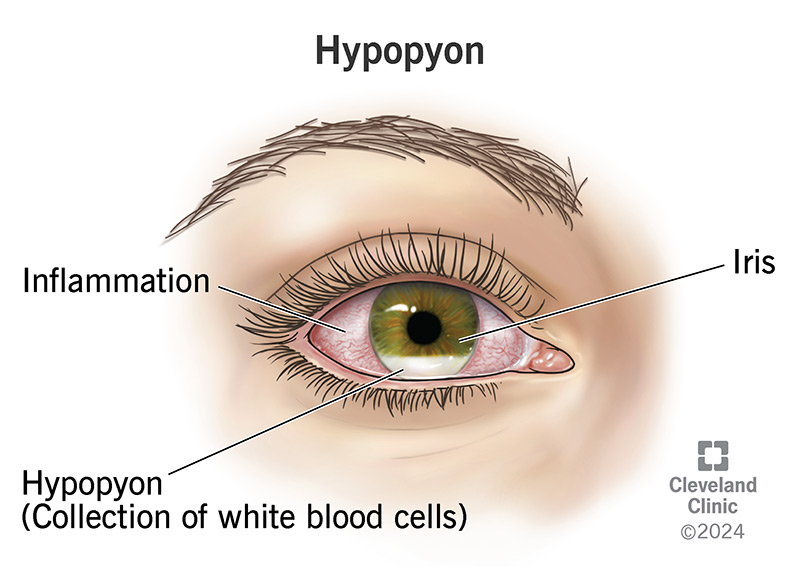Hypopyons are pools of white blood cells that get trapped in your eye’s anterior chamber (behind your cornea and in front of your iris). They form when a condition or infection causes inflammation in your eye. Treating the issue that caused a hypopyon will make it go away. Visit an eye care specialist right away to get the cause diagnosed as soon as possible.
Advertisement
Cleveland Clinic is a non-profit academic medical center. Advertising on our site helps support our mission. We do not endorse non-Cleveland Clinic products or services. Policy

A hypopyon is a collection of white blood cells that pools and gets trapped in the front part of your eye. Hypopyon is pronounced hy-POE-pee-on.
Advertisement
Cleveland Clinic is a non-profit academic medical center. Advertising on our site helps support our mission. We do not endorse non-Cleveland Clinic products or services. Policy
Hypopyons form in the anterior chamber of your eye — the space behind your cornea and in front of your iris. They can make your eye look like there’s a layer of white liquid stuck floating in front of the colored part of your eye.
Having a hypopyon in your eye usually means there’s an infection or another condition causing inflammation in the middle layers of your eye (uveitis).
Visit an eye care specialist right away if you notice a hypopyon in your eye. They’re usually not as serious or as scary as they look, but it’s important to get them diagnosed. And you’ll need treatment for the condition that’s causing the inflammation.
Hypopyons are collections of white blood cells — but they’re not pus or blood. Pus is a collection of dead white blood cells and germs that form around infections. But the white blood cells in a hypopyon don’t have germs in them. That’s why eye care specialists sometimes call them sterile pus.
Any issue that causes inflammation in your eyes can also cause hypopyons, including:
Advertisement
Inflammation is your body’s response to an injury or illness. When your immune system detects an invader like an infection, it sends white blood cells to that area to fight it off and help you heal.
If there’s an infection inside your eye, white blood cells will rush to that area. If you have an autoimmune disease, your immune system attacks healthy tissue in your body with white blood cells by mistake.
Hypopyons happen when too many white blood cells build up inside your eye. When they fill up all the available tiny spaces in your eye, extra cells flow out into the anterior chamber (the space between the layers at the front of your eye). It’s like too many people trying to crowd onto a busy escalator. Eventually, not everyone can fit and some people get shoved off at the entrance.
Depending on what’s causing it, you might experience other symptoms along with a hypopyon, including:
An eye care specialist will treat the condition or infection that caused the hypopyon. The extra white blood cells will drain out of your eye as that underlying condition gets better.
You may need:
Take antibiotics or antifungals exactly as your eye care specialist prescribes them. Take the full dose for as long as they say, even if you start to feel better. It’s important to take the full round of medication to make sure it can completely kill the bacteria or fungus.
It’s rare, but an untreated hypopyon can cause glaucoma in your affected eye.
The white blood cells built up in your eye can raise your intraocular pressure. Over time, that extra pressure can lead to angle-closure glaucoma or force your iris to stick to your lens or cornea (synechiae).
Visit an eye care specialist as soon as you notice any changes in your eyes or vision, especially if you can see something collecting in your eye.
Your eye care specialist will tell you how often you’ll need follow-up visits to manage the condition that caused the hypopyon and to check for changes in your eyes.
Hypopyons and hyphemas are both collections of fluid in the anterior chamber of your eye. The difference is what they’re made of and what causes them.
Hypopyons are pools of white blood cells. Infections and inflammatory health conditions cause them.
Hyphemas are pooled blood trapped in your eye’s anterior chamber. Eye injuries almost always cause them — especially sports injuries.
Advertisement
Your eyes do so much for you every day. They’re important to everything you do, and it can be scary to think something’s wrong. Especially when it’s an issue like a hypopyon you can see in the mirror. The white liquid in your eye is actually a sign that your body is trying to help you heal. But that doesn’t mean you can ignore a hypopyon. Visit an eye care specialist right away to get the cause diagnosed.
Your eye care specialist will help you understand what’s causing the hypopyon and how you can treat it. Once the underlying cause is managed you should feel (and see) better. Don’t be afraid to ask your eye care specialist questions. There’s no such thing as a silly question when it comes to your eyes and vision.
Advertisement
Cleveland Clinic’s ophthalmologists and optometrists have the highest training available. We provide exams, vision correction and care for many eye conditions.

Last reviewed on 11/25/2024.
Learn more about the Health Library and our editorial process.